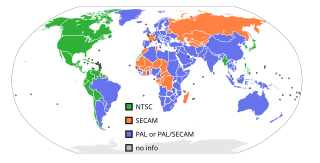
Phase Alternating Line (PAL) is a colour encoding system for analog television. It was one of three major analogue colour television standards, the others being NTSC and SECAM. In most countries it was broadcast at 625 lines, 50 fields per second, and associated with CCIR analogue broadcast television systems B, D, G, H, I or K. The articles on analog broadcast television systems further describe frame rates, image resolution, and audio modulation.

SECAM, also written SÉCAM, is an analog color television system that was used in France, Russia and some other countries or territories of Europe and Africa. It was one of three major analog color television standards, the others being PAL and NTSC. Like PAL, a SECAM picture is also made up of 625 interlaced lines and is displayed at a rate of 25 frames per second. However, due to the way SECAM processes color information, it is not compatible with the PAL video format standard. SECAM video is composite video; the luminance and chrominance are transmitted together as one signal.

Interlaced video is a technique for doubling the perceived frame rate of a video display without consuming extra bandwidth. The interlaced signal contains two fields of a video frame captured consecutively. This enhances motion perception to the viewer, and reduces flicker by taking advantage of the characteristics of the human visual system.
Broadcasttelevision systems are the encoding or formatting systems for the transmission and reception of terrestrial television signals.
The 405-line monochrome analogue television broadcasting system was the first fully electronic television system to be used in regular broadcasting. The number of television lines influences the image resolution, or quality of the picture.

Radiodiffusion-Télévision Française was the French national public broadcaster television organization established on 9 February 1949 to replace the post-war "Radiodiffusion Française" (RDF), which had been founded on 23 March 1945 to replace Radiodiffusion Nationale (RN), created on 29 July 1939. It was replaced in its turn, on 26 June 1964, by the notionally less-strictly government controlled Office de Radiodiffusion Télévision Française (ORTF), which itself lasted until the end of 1974.
Analog high-definition television has referred to a variety of analog video broadcast television systems with various display resolutions throughout history.

A number of experimental and broadcast pre World War II television systems were tested. The first ones were mechanical based and of very low resolution, sometimes with no sound. Later TV systems were electronic.
High-definition television (HDTV) describes a television or video system which provides a substantially higher image resolution than the previous generation of technologies. The term has been used since at least 1933; in more recent times, it refers to the generation following standard-definition television (SDTV). It is the standard video format used in most broadcasts: terrestrial broadcast television, cable television, satellite television.

CCIR System B was the 625-line VHF analog broadcast television system which at its peak was adopted by more than one hundred countries, either with PAL or SECAM colour. It is usually associated with CCIR System G for UHF broadcasts.
The 567-line television system was an experimental late 1940s proposal by Philips of the Netherlands for a European television system, with some test transmissions being made from Eindhoven.

625-line is a late 1940s European analog standard-definition television resolution standard. It consists of a 625-line raster, with 576 lines carrying the visible image at 25 interlaced frames per second. It was eventually adopted by countries using 50 Hz utility frequency as regular TV broadcasts resumed after World War II. With the introduction of color television in the 1960s, it became associated with the PAL and SECAM analog color systems.

CCIR System G, also known as the "Gerber Standard", is an analog broadcast television system used in sixty countries around the world for UHF channels. System G is generally associated with System B for VHF.

CCIR System I is an analogue broadcast television system. It was first used in the Republic of Ireland starting in December 1961 as the 625-line broadcasting standard to be used on VHF Band I and Band III, sharing Band III with 405-line System A signals radiated in the north and east of the country. The Republic of Ireland slowly extended its use of System I onto the UHF bands.

525-line is an American standard-definition television resolution used since July 1, 1941, mainly in the context of analog TV broadcast systems. It consists of a 525-line raster, with 486 lines carrying the visible image at 30 interlaced frames per second. It was eventually adopted by countries using 60 Hz utility frequency as TV broadcasts resumed after World War II. With the introduction of color television in the 1950s, it became associated with the NTSC analog color standard.
CCIR System E is an analog broadcast television system used in France and Monaco, associated with monochrome 819-line high resolution broadcasts. Transmissions started in 1949 and ended in 1985.
CCIR System F was an adaptation of System E used in Belgium and Luxembourg. With only half the vision bandwidth and approximately half the sound carrier offset, it allowed French 819-line programming to squeeze into the 7 MHz VHF broadcast channels used in those neighboring countries, albeit with a substantial loss of horizontal resolution. Use of System F was discontinued in Belgium in February 1968, and in Luxembourg in September 1971.

CCIR System N is an analog broadcast television system introduced in 1951 and adopted by Argentina, Paraguay and Uruguay, paired with the PAL color system (PAL-N) since 1980.

CCIR System L is an analog broadcast television system used in France, Luxembourg, Monaco and Chausey. It was the last system to use positive video modulation and AM sound.
CCIR System C is an analog broadcast television system used between 1953 and 1978 in Belgium, Italy, Netherlands and Luxembourg as a compromise between Systems B and L. Used on VHF only.







